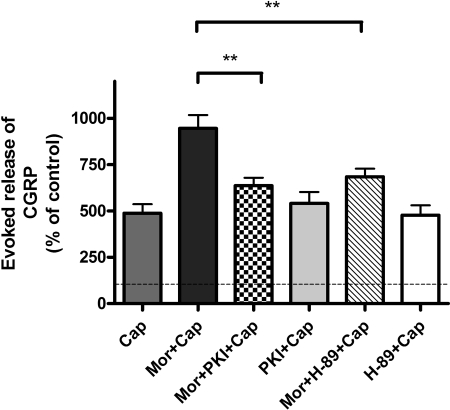Fig. 6.
Selective PKA inhibitors attenuate sustained morphine-mediated sensitization of capsaicin evoked CGRP release from neonatal rat DRG neurons. Cap, capsaicin (1 μM) treatment (10 min) of neonatal rat DRG neurons evokes CGRP release to 487 ± 48% basal (n = 5). Mor + Cap, sustained morphine (1 μM) treatment augmented capsaicin-evoked CGRP release to 946 ± 71% basal, which is a 94% increase relative to Cap alone (***, p < 0.001 relative to Cap, one-way ANOVA; n = 5). Mor + PKI + Cap, pretreatment (1 h) of the cells with 50 nM PKI followed by 24-h coincubation with morphine (1 μM) attenuated the effect of sustained morphine treatment on capsaicin (1 μM; 10 min)-evoked CGRP release by 67% relative to Mor + Cap group (**, p < 0.01 relative to Mor + Cap, one-way ANOVA; n = 5). PKI + Cap, treatment of the DRG neurons with 50 nM PKI followed by stimulation with 1 μM capsaicin had no effect on capsaicin-evoked CGRP release [542 ± 61% basal, p > 0.05 relative to Cap (487 ± 48% basal), one-way ANOVA; n = 5]. Mor + H-89 + Cap, pretreatment (1 h) of the cells with H-89 (1 μM), followed by 24-h coincubation with the inhibitor in the presence of morphine (1 μM) attenuated sustained morphine-mediated augmentation of capsaicin (1 μM; 10 min)-evoked CGRP release by 57% relative to Mor + Cap group (**, p < 0.01, one-way ANOVA; n = 5). H-89 + Cap, treatment of the DRG neurons with 1 μM H-89 alone caused no difference in basal CGRP release relative to capsaicin alone [478 ± 53% basal, p > 0.05 relative to Cap (487 ± 48% basal), one-way ANOVA; n = 5]. The results (mean ± S.E.M.) are expressed as the percentage of basal CGRP release from unstimulated DRG neurons.

